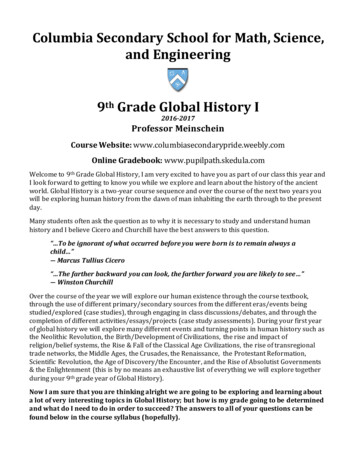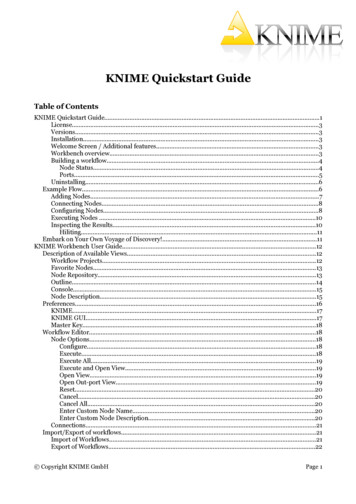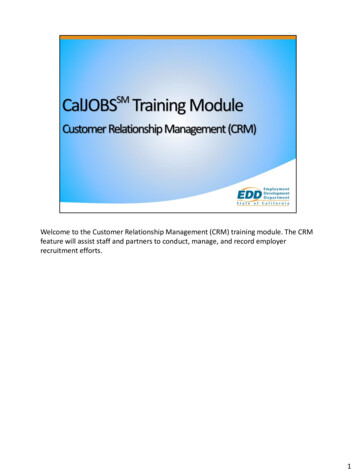![WELCOME 1 [acribbons.weebly ]](/img/32/roe-full-book-2019-4-1-19.jpg)
Transcription
WELCOME1Hello,I am pleased to welcome you to our eleventh annual Ribbons of Excellence Day Program at Adrian College, a day dedicated to celebrating scholarly accomplishments ofour student through presentations, exhibitions, and performances. A tradition startedin 2008 and developed out of a faculty initiative to create and support our academicculture, today is the culmination of at least one year of preparation by students andtheir mentors.The Ribbons of Excellence form the foundation of our shared values at AdrianCollege and each presentation today is linked to at least one thematic ribbon. I wouldlike to thank Dr. Elizabeth McGaw and the team of faculty and staff who worked insupport of this event. We are thrilled that you are joining us today to celebrate ourstudents and their accomplishments.Best regards,Dr. Andrea R. MilnerVice President and Dean of Academic AffairsAdrian College’s Mission StatementAdrian College, a liberal arts collegein the United Methodist tradition, iscommitted to the pursuit of truth anddignity of all people. Through activeand creative learning in a supportivecommunity, undergraduate and graduatestudents are challenged to achieveexcellence in their academic, personal,and professional lives, and to contributeto a more socially just society.
2WELCOMEWelcome,This is such an exciting day on campus, one of my favorite each year. This is the daywe get to celebrate all the great things that our Adrian College students and facultywork so hard on throughout the year. This is the time we get to celebrate scholarshipand encourage learning and growing. I really hope you enjoy all of the presentationsas much as I do and have a great day celebrating our students.The history of the Ribbons of Excellence Program resides in the Cane Ceremonytradition of tying a ribbon with the names of graduates to the Shepherd’s Crook. Thistradition has been carried on since 1887; in 2007 the academic community at AdrianCollege developed its academic vision of the Ribbons of Excellence Program. TheRibbons of Excellence are what each and every member of our community strivesfor; the Ribbons of Excellence are what we want Adrian College to be known for:caring for humanity and the world; learning throughout a lifetime; thinking critically;crossing boundaries and disciplines; and developing creativity.Through today’s Program we strive to achieve this goal of making this visiona reality. Students embark in research and other projects to think critically andcreatively and to tie these ribbons into their lives, not just to the Shepherd’s Crook.We also strive to achieve learning throughout a lifetime and caring for humanityby inviting community members, faculty, staff, students and other visitors to attendthe day’s events. The day is also about crossing boundaries and disciplines, as weare trying to expose students, through their presentations, to other buildings andcommunities on campus.On behalf of the Ribbons of Excellence Program Committee, I would like tothank everyone involved in this day for your hard work and especially all of youattending. Thank you for all you did to make the 2019 Ribbons of Excellence DayProgram outstanding.Regards,Elizabeth A. McGaw, Ph.D.Director, Ribbons of Excellence ProgramAssociate Professor, Department of Chemistry & Biochemistry
TABLE OF CONTENTS3Campus Map . . . . . . . . . . . . . . . . . . . . . . . . . . . . . . . . . . . . . . . . . . . . . . . . . . . . . . . . . . . . . . . . . . 4Conference Schedule. . . . . . . . . . . . . . . . . . . . . . . . . . . . . . . . . . . . . . . . . . . . . . . . . . . . . . . . . . . . 5Opening Session. . . . . . . . . . . . . . . . . . . . . . . . . . . . . . . . . . . . . . . . . . . . . . . . . . . . . . . . . . . . . . . . 6Keynote. . . . . . . . . . . . . . . . . . . . . . . . . . . . . . . . . . . . . . . . . . . . . . . . . . . . . . . . . . . . . . . . . . . . . . . 7List of Sessions. . . . . . . . . . . . . . . . . . . . . . . . . . . . . . . . . . . . . . . . . . . . . . . . . . . . . . . . . . . . . . . . . 8AbstractsSession 1 (9:30 - 10:30 am). . . . . . . . . . . . . . . . . . . . . . . . . . . . . . . . . . . . . . . . . . . . . . . . . . 12Session 2 (10:45 - 11:45 am). . . . . . . . . . . . . . . . . . . . . . . . . . . . . . . . . . . . . . . . . . . . . . . . . 19Poster Session (11:45 am - 12:30 pm). . . . . . . . . . . . . . . . . . . . . . . . . . . . . . . . . . . . . . . . . . 27Meet the Artist (11:45 am - 12:30 pm). . . . . . . . . . . . . . . . . . . . . . . . . . . . . . . . . . . . . . . . . 34Session 3 (2:00 pm - 3:00 pm). . . . . . . . . . . . . . . . . . . . . . . . . . . . . . . . . . . . . . . . . . . . . . . . 34Session 4 (3:15 pm - 4:15 pm). . . . . . . . . . . . . . . . . . . . . . . . . . . . . . . . . . . . . . . . . . . . . . . . 41Alpha Chi Induction. . . . . . . . . . . . . . . . . . . . . . . . . . . . . . . . . . . . . . . . . . . . . . . . . . . . . . . . . . . . . 47Acknowledgements. . . . . . . . . . . . . . . . . . . . . . . . . . . . . . . . . . . . . . . . . . . . . . . . . . . . . . . . . . . . . 48Author Index. . . . . . . . . . . . . . . . . . . . . . . . . . . . . . . . . . . . . . . . . . . . . . . . . . . . . . . . . . . . . . . . . . 49
4CAMPUS MAP
CONFERENCE SCHEDULE58:15 – 9:15 amRegistration & Breakfast. . . . . . . . . Dawson Auditorium8:45 – 9:15 amOpening Session. . . . . . . . . . . . . . . . Dawson Auditorium9:30 – 10:30 amSession 110:30 – 10:45 amBreak10:45 – 11:45 amSession 211:45 am – 12:30 pmPoster Session. . . . . . . . . . . . . . . . Peelle Addition Lobby11:45 am – 12:30 pmMeet the Artist. . . . . . . . . . . . Valade Gallery (Shipman)12:30 pm – 2:00 pmLuncheon (invited). . . . . . . . . . . . . Adrian Tobias RoomKeynote Address2:00 – 3:00 pmSession 33:00 – 3:15 pmBreak3:15 – 4:15 pmSession 44:30 – 5:30 pmAlpha Chi Induction Ceremony . . . . . . . Herrick ChapelPersonal ScheduleTIMEPRESENTER/ABSTRACTLOCATION
6OPENING SESSION“Correlating Creativity with Kindness.”Dr. Mary Marks, Department of MusicMarty Marks is finishing his 14th year as Director of Bands at AdrianCollege, where he leads the concert and marching bands. He holds degrees inmusic education, clarinet/saxophone performance and wind band conducting.Dr. Marks is also an Army Reserve Band Musician, the Commander of the395th Army Band in Mustang, Oklahoma. He has been an army reservistsince 1983. He is an adjudicator for and honorary member of the MichiganSchool Band and Orchestra Association, and works as a school bandconsultant, guest conductor, marching band drill designer and arranger, andfreelance musician throughout Michigan and Ohio.NOTICEBreakfast will be served in Dawson Lobby beginning at 8:15 amOpening Session will be held in Dawson Auditorium at 8:45 amKeynote address will begin at 1 pm in the Adrian Tobias Room (Ritchie)Doors will open at 12:30 pm and all are welcome to attendDesserts will be servedYou may bring your lunch from Ritchie to eat during the presentation
KEYNOTE7A Very Potter Home in the WoodsRev. Eric A. Stone ‘89Six years ago Eric was asked to develop and lead a new camp event at Camp Kinawind.Eric combined his passion for church camping, his love of JK Rowling’s Harry Potterbooks and movies, his theological grounding, and the help of many others to create, “AVery Potter Camp” which has been Camp Kinawind’s best attended summer camp fouryears running. Today he shares the creative process he used to develop this magical andmystical camp experience.This summer was meant to be year 5 for “A Very Potter Camp” at Camp Kinawind.Sadly, the Michigan Area United Methodist Camping Board decided to close 4 campsincluding Camp Kinawind in February of this year. While efforts are currently underwayto reopen Camp Kinawind, the future is uncertain.Rev. Eric A. Stone is the pastor at St. Luke’s United Methodist Church in Essexville,MI. This is his 25th year in full time ministry, having served 3 churches and 3 campusministries. Eric graduated from Adrian College (1989) where he flirted with Biologybut blames an overwhelming ennui when it came to memorizing fish for switching toCommunications/Theatre. He saw an opportunity to combine his love of theatre with histheological education at the Methodist Theological School in Ohio where he earned hisMDiv and a Master of Arts in Liturgical Arts.Eric was born and raised in Adrian. He met Sherry Rokita on the summer staff at JudsonCollins Camp in 1986 (but did not have a camp romance!) They were married May 28,1988 in the Adrian College Chapel. Sherry graduated from Adrian College in 1990.Eric and Sherry have two boys Jacob 22(who graduated from Adrian College inDecember 2018) and Julian 19.The Stones love for camping hascontinued, especially at Camp Kinawindin northern Michigan where Eric andSherry have been on staff or volunteeredfor many years. Sherry is the currentCamp Director and Jacob has been onstaff for five years. Eric returned tothe stage after an 18 year hiatus andis currently in rehearsals for his 5thproduction at the Bay City Players.
SESSIONS8PLACETIMETITLEPRESENTOR(S)Jones1109:30 – 9:50The Effects of Blood Flow Restriction on MuscleActivation During Functional Exercise in Individuals withChronic Ankle InstabilitySavannah MonetteJones1109:50 – 10:10The Effects of Peppermint on Single Leg Balance andHandgrip on Healthy Young AdultsAusteen FreemanJones11010:10 – 10:30Comparison of the Effectiveness of Cupping and IASTMon Hamstring ROM, PPT, and PFAQ ScoresJacob ClarkPeelle2079:50 – 10:10Students for a Democratic Society’s Definition of SocietyMolly KorthasePeelle20710:10 – 10:30Democracy with Consideration for Political Culture: ThePhenomenon of Pacific Island StatesClarence KennedyPeelle2129:30 – 9:50Science, Technology & Congress: The Debate onTechnology Assessment & Expertise in CongressCody SchaubPeelle2129:50 – 10:10Cyberspace Symbiosis: The relationship betweenTechnology and Public Policy in the 21st CenturyLiam TappPeelle3019:30 – 9:50Fall Phenology in Southeast Michigan ShrubsAllison ThomasPeelle3019:50 – 10:10Do native shrub species demonstrate soil-based habitatpreferences in a southeast Michigan forest?Mahala LorenzoPeelle30110:10 – 10:30Do soil nutrient-based habitat associations drive distributionsof invasive shrubs in a southeast Michigan forest?Molly BeckValade1309:30 – 9:50You Can’t Sit With UsKylee DotyValade1309:50 – 10:10We are Animals in SocietyKaitlin ParisiValade13010:10 – 10:30Social Penetration in “The Internship”Gage Dansby9:30 – 10:30Williams Oratorical CompetitionMitchell Doyle,Laurel Krause,Lauren Lukac,Alivia Rebeck,Emily Slagter,and Alexis Weston10:30 – 10:45BREAKJones11010:45 – 11:05Developing Creative Journeys Across theAdrian College CampusVictoria Olijar andAlexis KachallaJones11011:05 – 11:252019 State of Adrian College’s Environmental StewardshipMorgan PearcePeelle20710:45 – 11:05Foraminiferal paleoecology and paleotemperatureestimates for the Cenomanian (100-94 Ma) athigh paleolatitudesRebecca GoughnourPeelle20711:05 – 11:25Paper and Ink: A Historical and Chemical PerspectiveMolly BeckPeelle20711:25 – 11:45The History, Science, And Demonstration ofRaku Fired CeramicsEmily ArcherDowns HallTheatrePeelle212The Effects of the 2nd Skull Skullcap to Attenuate Forces10:45 – 11:05Resulting From Foul Ball Impacts Into Two DifferentCatchers MasksRebecca Neal
SESSIONSPLACE9TIMETITLEPRESENTOR(S)Peelle21211:05 – 11:25The Effect of Sport Specialization on Hip & GroinSymptoms in Collegiate Hockey PlayersMarisa SheppardPeelle21211:25 – 11:45Times Have Not Changed: The Gender EqualityProblem in HockeyCarly CostelloPeelle30110:45 –11:05A Year in the Life of the Vertebrate Fauna at Walden WestJacob StonePeelle30111:05 –11:25Changes in Animal Behavior when Stimuli of Non-NativeAnimals are Introduced into the Habitat at Walden WestSamantha RoeslerPeelle30111:25 – 11:45Is there an evolutionary signal in susceptibility to Whitenose Syndrome in Chiroptera?Morgan WizaValade13010:45 –11:05Construal Bias in LanguageSara Anthony, MeganDeBrabander, EmaleeKerr, Rachel Rodeheffer,Michelle Siegel,Olivia Stobinski andMadeline TamlynValade13011:05 –11:25Censorship in High School English Classes: Why WeShouldn’t F**king Have ItNatalia YounanDowns HallTheatre10:45 – 11:05Drews, Alex. The EntertainerAlex DrewsDowns HallTheatre11:05 –11:25Christopher, Leigh. This Is Me.Leigh ChristopherKiln Shed(Caine)12:00 – 12:30Demonstration of Raku Fired CeramicsEmily ArcherPeelleAdditionLobby11:45 – 12:30Effects of Positive and Negative Framing of Informationabout Down Syndrome on Decision-making Post NonInvasive Prenatal TestingPaige CubberlyPeelleAdditionLobby11:45 – 12:30The Effects of Education and Indirect ContactInterventions on Mental Health StigmaMegan DeBrabanderPeelleAdditionLobby11:45 – 12:30Effects of adolescent alcohol exposure on markers ofcholinergic interneurons in striatal tissue of adult ratsMichael DouglasPeelleAdditionLobby11:45 – 12:30The Effects of Aerobic Eccentric Exercise Training on theVentilatory Threshold in Untrained IndividualsKayla DurbinPeelleAdditionLobby11:45 – 12:30Testing for the Presence of Estrogen in theRiver Raisin WatershedMara EasonPeelleAdditionLobby11:45 – 12:30The Effects of Garlic and Garlic Mustard on Soil BacteriaMara EasonPeelleAdditionLobby11:45 – 12:30Motivational Factors of Collegiate StudyingJenna EhredtPeelleAdditionLobby11:45 – 12:30Patterns of Surface Subsidence in the City of Adrian andTheir CauseKorey MazurPeelleAdditionLobby11:45 – 12:30Strategies in Writing Blog-Style Environmental LiteratureMcKayla Moran
Lobby11:45 – 12:30Evolution of costal grooves in salamandersAlana PastulaPeelleAdditionLobby11:45 – 12:30The Desk Top Delta: Evaluating cause and effectrelationships between deltaic sedimentation behavior andexternal variables.Garrett PowellPeelleAdditionLobby11:45 – 12:30Effect of Symptom Dimension and Familiarity onRecognition and Stigmatization ofObsessive-Compulsive DisorderMichelle SiegelPeelleAdditionLobby11:45 – 12:30Relationship different soil types have with plant life atWalden West, Tipton, MIOlivia ZiembaValadeGallery(Shipman)11:45 – 12:30Conditions of Reclamation: Reconciliation, Repossession,Resurgence, ResponseKellen Taylor,Patrick Dunn,Rachel Oswalt, andKaye KecklerRush1242:00 – 3:00Star Light Writing Award and Mahan Manuscript HonorsAward PresentationsHaley Carpenter, LaurelHammis, AutumnCramer, Taylor Petit, andAnna WozniakRush1162:00 – 2:20Reconsidering the Political Role of Native Americans:Wheelock and His Indian Charity SchoolMax RuffRush1162:20 – 2:40Predicting Attitudes Toward Lesbian Women, Gay Men,Transgender Individuals, and Their RightsMegan DeBrabanderRush1162:40 – 3:00Transitions: Creating LGBT- Inclusive SpacesBrodie LobbValade2022:00 – 2:20Two Languages, One Classroom:The Education of Bilingual Students in the United StatesCarly ThomasValade2022:20 – 2:40Video Game Theory and the College Academic ProcessCheyenne SliterValade2022:40 – 3:00Analysis of Trends for Inquiry and Risk Taking inFacilitating Teacher LeadershipDarcy RenaudValade1252:00 – 2:20Comparison of xylem and stomatal traits in invasive andnative shrubs of a Southeast Michigan forestPaige Cubberly andMargaret AmoryValade1252:20 – 2:40Observational Study of Kiwanis Trail Invasive SpeciesMaxwell BirminghamValade1252:40 – 3:00Maintenance of Relative Species Abundance by PathogensAlex MercerValade1302:00 – 2:20Sustainability: Balancing People, Profit, and PlanetMariah Kramer, CaseyCribbs, Mady Crandle,and Lillian BrueckmanValade1302:20 – 2:40Rebranding the Hot Dog - WienerschnitzelElizabeth Graves, JosephHerrera, Julia Maltbie,and Nolan DudaValade1302:40 – 3:00The Juxtaposition of Our Words and Actions:A Talk About EthicsColleen CaterDownsHallTheatre2:00 – 2:20Musical Communication Beyond the Language BarrierCharlie Penn
SESSIONSPLACETIMEDownsHallTheatre2:20 – 2:40TITLELike Breathing: The Creative Process Of a MusicalTheatre Recital11PRESENTOR(S)Alexandrea McCarty3:00 – 3:15BREAKRush1243:15 – 3:35Sub-Surface Nutrient Flow in Row Crop Systems of theSouth Branch of the River RaisinCorrin Logan,Caitlynn Dellinger,Karter Reedy,and Mark HendersonRush1243:35 – 3:55Implementing a non-parametric overlap index with RIan O’BanionRush1243:55 – 4:15Blood Vessel Pattern Analysis Using Statistical andMathematical MethodsAshley Oramand Gabe LopezRush1163:15 – 3:35The Effects of Latino Culture on Mental Health Stigmaand Treatment-Seeking Behaviors in the United StatesMegan DeBrabanderRush1163:35 – 3:55Examining Perceived Social Support and Mental Health ina Sample of College AthletesLauren KrywyRush1163:55 – 4:15“The Season of Overcoming” Adrian College MarchingBand Show 2018Blayk OlsenValade2023:15 – 3:35Poetry PerformanceInocenciaRamirez-GorskiValade2023:35 – 4:15Poetry ReadingTaylor Anson,Sydney Babcock,Kaysie Burnside,Anthony Bussing,Emma Brockett,Samantha Glaza,McKayla Moran,Inocencia RamirezGorski, Hannah Roegner,Emma Sheldon,and Michelle SiegelValade1253:15 – 3:35The Evolution of Fashion: Androgyny in Dress TodayAnna ShepherdValade1253:35 – 3:55The Dress Detective: An Exploration of aGeoffrey Beene GarmentMorgan PearceValade1253:55 – 4:15Art Infused Trend AnalysisBethany Dziekan andMorissa BeckmanValade1303:15 – 3:35“What Slavery Started Is Not Over Yet:” James Madison’sMontpelier And The Problem Of Slavery In Public HistoryKayla WendtValade1303:35 – 3:55Media Framing & The O.J. Simpson InvestigationJustin McMannHerrickChapel4:30 – 5:30Alpha Chi Induction Ceremony
12ABSTRACTSThe Effects of Blood Flow Restriction on Muscle Activation During Functional Exercise inIndividuals with Chronic Ankle InstabilityPresenter: Savannah MonetteMentors: Dr. Erin Garmyn and Dr. John GoetschiusRibbons: Caring for Humanity and the World and Thinking CriticallySession/Time/Location: 1A, 9:30 – 9:50, Jones 110Abstract: Background: Ankle sprains are the most common physically active musculoskeletalinjury. Many individuals who sprain their ankle go on to suffer from a condition known as chronicankle instability (CAI), which is associated with chronic lower-leg muscle dysfunction. Bloodflow restriction (BFR) is a technique that involves the application of a tourniquet to occlude distalblood flow and has been showed to improve muscle function during rehabilitation exercises.The Star Excursion Balance Test is a common functional exercise for ankle rehabilitation,and combining BFR with the SEBT may allow for enhanced muscle function during anklerehabilitation exercises for CAI patients. The use of BFR during ankle rehabilitation is not wellstudied; therefore, the purpose of this study was to examine the effects of BFR on lower-legmuscle activation of the tibialis anterior, fibularis longus, and lateral gastrocnemius during theSEBT in young adults with CAI.Methods: This was a cross over study in which lower-leg electromyography (EMG) muscleactivation was measured during the SEBT under two conditions, with BFR and without BFR(control). Individuals aged 18-35 with a history of CAI completed two laboratory visits, one witheach condition. For the BFR condition, the cuff was inflated to 60% limb occlusion pressureduring the SEBT. For Non-BFR condition, the cuff was not applied. EMG muscle activation wascompared between conditions, BFR and control, using a repeated measure ANOVA with post-hoctests.Results and Conclusions: Data collection is still ongoing. The final conclusions will be presentedat the ROE Conference.The Effects of Peppermint on Single Leg Balance and Handgrip on Healthy Young AdultsPresenter: Austeen FreemanMentors: Dr. Tony Coumoundouros, Mrs. Meg Sharp, Dr. Erin Garmyn, and Dr. Heather SchuylerRibbons: Crossing Boundaries and Disciplines and Thinking CriticallySession/Time/Location: 1A, 9:50 – 10:10, Jones 110Abstract: Context: The aim of this study was to examine the effects of peppermint oil onconcentration, focus strategies, single leg balance and hand grip. The effects of peppermint oil hasshown to improve exercise performance and cognition while no evidence exists surrounding theeffects on balance, cognitive focus strategies and concentration during balance.Objective: The objective of this study was to compare the effectiveness of peppermint essentialoil, peppermint altoids and control on single leg balance, hand grip, concentration and focusstrategies.Design: This is a within-subjects cross over design with counter balancing and a wash out periodin a laboratory setting. Three sessions were required of each participant, one for peppermintessential oil, one for the altoids comparison and one for the control.Participants: Study participants were selected through convenience sampling, were between theages of 18-35 and able to single leg balance for 30 seconds. Individuals with a known allergy orsensitivity to peppermint, have used peppermint in the last 14 hours, had a lower leg injury in thepast 6 months, or weighed less than 99 pounds were excluded from the study.Interventions: Peppermint essential oil was used as the intervention and altoids were thecomparison.Main Outcome Measures: All outcomes measures were taken immediately before and after theintervention, comparison and control.Results: In processConclusions: In Process
ABSTRACTS13Comparison of the Effectiveness of Cupping and IASTM on Hamstring ROM, PPT, andPFAQ ScoresPresenter: Jacob ClarkMentor: Dr. Heather SchuylerRibbons: Crossing Boundaries and Disciplines and Thinking CriticallySession/Time/Location: 1A, 10:10 – 10:30, Jones 110Abstract: Context: This Study examined the effectiveness IASTM and Cupping when treatingpatients with a history of hamstring Injury. The cupping technique used in this study, whichincorporates static cupping, dynamic cupping, and active/passive movements, has not beencompared to other forms of myofascial release.Objective: The objective of this study is to compare the effectiveness of IASTM and Cupping atimproving hamstring ROM, PPT, and PFAQ scores in patients with a history of hamstring injury.Design: This is a within-subjects controlled laboratory study with two independent variablesand three dependent variables. Two sessions were required of each participant, one for eachintervention.Participants: Participants were recruited on a volunteer basis, aged 18-35 with a history ofhamstring injury within the last 12 months.Interventions: Cupping: Each participant received 3 minutes of static cupping, preformed activeand passive motions with cups in place, and received 3 minutes of dynamic cupping for an8-minute total treatment time. IASTM: Each participant received a total of 8 minutes of treatmentwith Graston tools. First, they received two minutes of scraping with the G1 tool followed by 6minutes of scraping with the G4 tool.Main Outcome Measures: All outcomes measures were taken immediately before and aftereach intervention. ROM was taken using an active knee extension measured with a standardgoniometer. PPT was measured with a handheld dynamometer. Patients also filled out the PFAQbefore and after each interventionResults: TBDConclusions: TBDStudents for a Democratic Society’s Definition of SocietyPresenter: Molly KorthaseMentor: Dr. Deborah FieldRibbons: Thinking Critically and Caring for Humanity and the WorldSession/Time/Location: 1B, 9:50 – 10:10, Peelle 207Abstract: The 1960s are recalled as a time of societal, cultural, and political unrest. In the midstof this, the group Students for a Democratic Society, SDS, began at the University of Michigan.Civil rights issues and a call for the end of involvement in Vietnam ignited the movement, whichthen spread through campuses around the country. This presentation is focused on the rhetoricwithin SDS to examine the group’s definition of democracy. SDS was a prolific organization,leaving speeches, newsletters, and publications. These sources formed the basis for my research.Democracy, according to SDS, is not a passive belief, but rather a process and a set of aspirations.SDS tried to create democracy by becoming more educated, more involved, and pursuing equalityfor all. In modern day America dissent groups are often cast as anti-American. The research Ihave conducted has revealed SDS as a group that contradicts this rhetoric. Contrary to the notionof destroying an American ideal, SDS was attempting to reclaim and redefine the inherentlyAmerican value of democracy.Topic Area: Humanities
14ABSTRACTSDemocracy with Consideration for Political Culture: The Phenomenon of Pacific Island StatesPresenter: Clarence KennedyMentor: Dr. James HanleyRibbons: Thinking Critically, Caring for Humanity and the World, Developing Creativity,Crossing Boundaries and Disciplines, and Learning Throughout a LifetimeSession/Time/Location: 1B, 10:10 – 10:30, Peelle 207Abstract: The only states that have not become stable, democratic states are those that havehistorically had a very different culture than that of the west. To confront this issue we needto consider how best to appeal to all cultures with the benefits of freedom in democracy. Inresearching the Pacific Island States, a prominent, and newly democratic region of the World.This has brought up the importance of “Freedom from” rather than promotion for “Freedom to” indemocratization. By adhering to a principle of liberty for the people, grounded mostly in freedomof speech and press, the agents of culture change, intellectuals and mass media, will lead to thespread of subjective and individual freedom. This is contrary to common foreign policy that hassworn to be the savior and redeemer of the oppressed people of the world.Topic Area: Social ScienceScience, Technology & Congress: The Debate on Technology Assessment & Expertisein CongressPresenter: Cody SchaubMentor: Dr. James HanleyRibbons: Thinking Critically, Crossing Boundaries and Disciplines Edit, Learning throughout aLifetime, Caring for Humanity and the World, and Developing CreativitySession/Time/Location: 1C, 9:30 – 9:50, Peelle 212Abstract: Science and technology are two of the most important aspects of today’s society.Members of Congress have displayed a lack of understanding in today’s relevant issues in scienceand technology. The increase in need for expertise in the topic areas of science and technology hasgained relevance in today’s society. This paper delves into the role of the Office of TechnologyAssessment in its effort to increase the expertise in Congress while it was active; while examiningthe need for technology assessment in Congress today. The history of technology assessment inCongress is explored while focusing on the current debate to bring back a technology assessmentfunction. There are currently congressional studies in progress to determine if there is a needfor technology assessment. Those studies will determine how Congressional expertise will bestructured in the future.
ABSTRACTS15Cyberspace Symbiosis: The relationship between Technology and Public Policy in the21st CenturyPresenter: Liam TappMentor: Dr. James HanleyRibbons: Crossing Boundaries and Disciplines and Learning Throughout a LifetimeSession/Time/Location: 1C, 9:50 – 10:10, Peelle 212Abstract: The purpose of this presentation is to discuss and expand on the topics discussed inthe course PSCI 451: Technology Policy in the 21st Century. The main argument being presentedis the co-dependent nature of Technology and Public Policy (Politics) in an increasingly digitalworld. With references to historical parternships such as radio pointing out the need for thegovernment to find new avenues to operate.A broad range of cases and innovations that helped strengthen and intertwine the reliance ofgovernment institutions on the ease of innovation, and the nature of technology to be bound towhat resources are avaliable. Topics include:Internet 2.0Individual Liberty vs. ProtectionCybersecurity/SurvelliencePublic Vs. Private SectorAmerican vs. European action and implementationDigital Political ActivismAll topics being discussed provide context and support for the previously given argument, andare meant as an introduction into the fairly broad and untapped source of debate that is therelationship between technology and government.Fall Phenology in Southeast Michigan ShrubsPresenter: Allison ThomasMentor: Dr. Jeffrey LakeRibbons: Thinking CriticallySession/Time/Location: 1D, 9:30 – 9:50, Peelle 301Abstract: Invasive species – that is, organisms not native to their current habitat – are becominga major threat to biodiversity and ecosystem function across the globe. In southeast Michiganforests, several horticultural shrubs have become naturalized and now invasive. Understandingthe mechanisms by which they have succeeded in invading may provide clues as to how theymay be controlled. It has been observed that the species may leaf out earlier than native shrubs,and also hang onto their leaves longer into the fall. However this has not been quantified for eachspecies in Michigan; nor has it been considered over multiple years. This study focused on the fallphenology of native and invasive shrubs at Walden West, measuring number of leaves remainingon a weekly basis throughout the autumn. This work asked if the shrub’s light environmentaffected leaf fall on each individual. The work was carried out on six species – five invasive(Lonicera maackii, Rhamnus cathartica, Berberis thunbergii, Elaeagnus umbellata, and Rosamultiflora), and one native (Lindera benzoin). For each species, ten individuals were selected;on each plant, three branches of ten leaves each were followed weekly for 10 weeks, countingthe number of leaves remaining. Invasive species did, in fact, lose their leaves significantly laterthan native species, but they did not all behave identically; there were also interactions with lightenvironment found. This work best fits the Ribbon “Thinking Critical” because the researchrequired substantial problem solving and scientific process. pag
Peelle 207 10:45 - 11:05 Foraminiferal paleoecology and paleotemperature estimates for the Cenomanian (100-94 Ma) at high paleolatitudes Rebecca Goughnour Peelle 207 11:05 - 11:25 Paper and Ink: A Historical and Chemical Perspective Molly Beck Peelle 207 11:25 - 11:45 The History, Science, And Demonstration of Raku Fired Ceramics Emily .

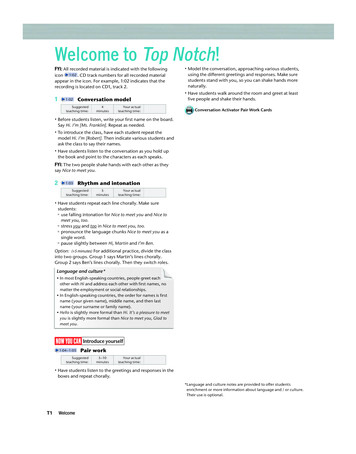

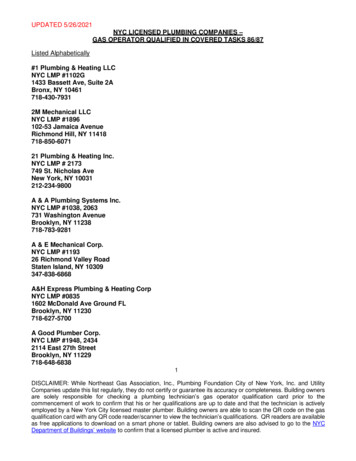
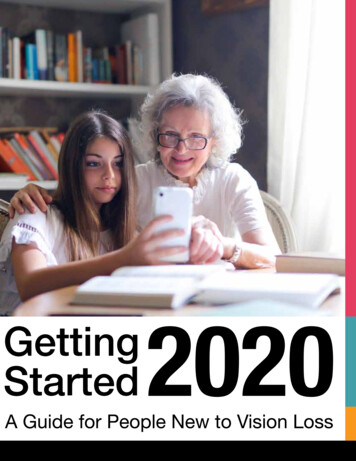
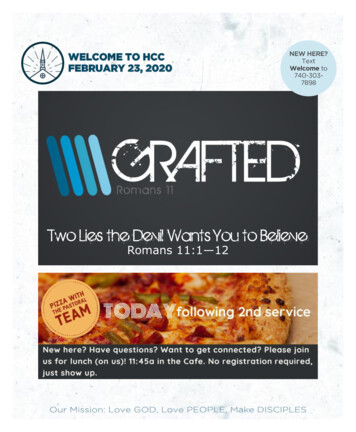

![WELCOME [bluesignworldwide1.weebly ]](/img/12/dreamtrips-2019-11-pdf.jpg)
